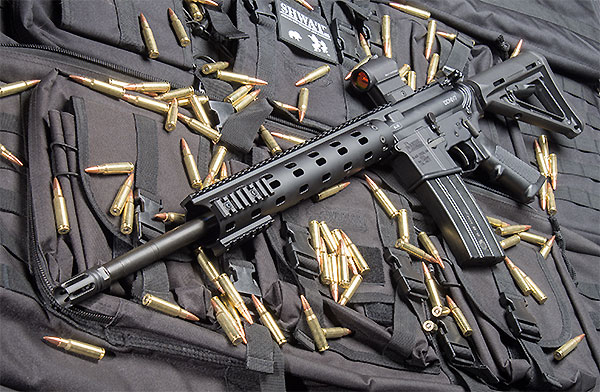
What is quality? You read a gun review, and it seems like more often than not you get something like this: “With a name like X, you know you’re getting quality.” With the number of solid AR-15 manufacturers in the market today, there’s probably some truth to that. Some aspects of a gun are more important to user A than to user B, so a bit of subjectivity might be allowed here.
This will be our first look at the Daniel Defense M4V7, a unique configuration in the less common 6.8 SPCII chamber. We’ll take a look at the most obviously unique part of the build, the Modular Float Rail (MFR) compared to other rails, the 6.8 round this rifles shoots, and some finer points of importance in the quality department.
The MFR rail on this rifle is a departure for me. I’ve always run quad rails with the justification that I could readily adapt them to whatever scenario presented itself. New IR laser to try? No problem. New vertical grip? Easy. White light? Infrared Illuminator? Piece of cake, plug and play on the quad rails.
All that rail space comes with a price, though, measured in weight and dollars. For example, the Daniel Defense twelve inch AR15 Lite Rail weighs 17.4 ounces and retails for $395. The same length tubular MFR on this M4V7 weighs 12.2 ounces and retails for $255.
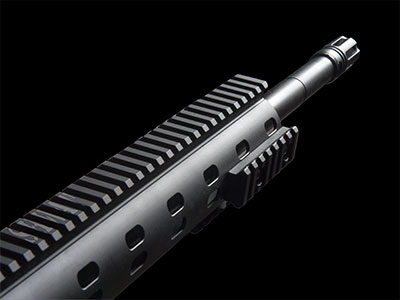 Numerous manufacturers have introduced the smooth tubular rails in the last couple of years, and I’ll admit I’ve been curious about them. There’s definitely something to be said about the smooth narrow tube. I’m in the habit of using a vertical grip as an index point for my hand, so lacking that I found myself hunting for the optimal hand position. However, with an outside diameter virtually identical to an empty cardboard paper towel roll tube, it hits a sweet spot in the ergo department.
Numerous manufacturers have introduced the smooth tubular rails in the last couple of years, and I’ll admit I’ve been curious about them. There’s definitely something to be said about the smooth narrow tube. I’m in the habit of using a vertical grip as an index point for my hand, so lacking that I found myself hunting for the optimal hand position. However, with an outside diameter virtually identical to an empty cardboard paper towel roll tube, it hits a sweet spot in the ergo department.
The MFR has a continuous picatinny rail on top to address the needs for any optic consideration or iron sights. It also comes with three 3 inch movable rail sections that can be set aside for a smooth rail, or positioned to hold lights, bipods, etc. For the purpose of this review, I left everything as it came from Daniel Defense.
Under the twelve inch MFR is an eighteen inch S2W cold hammer forged barrel and mid length gas system. Rifling is a 1:11 twist. S2W translates to “Strength to Weight” profile. It’s not a government profile, nor a lightweight pencil barrel. Instead, it’s closer to what you’d expect on a bolt-action rifle with a taper that narrows towards the muzzle. Daniel Defense created this design to increase accuracy.
Eighteen inches seems long to me. I like shorter, lighter as a general rule. The longer barrel gives the 6.8 bullet some 50 feet per second increased velocity over a sixteen inch, and still leaves the overall length shorter than some more traditional hunting rifles. Handling the gun, it really doesn’t seem too long, but maybe a bit muzzle heavy. Maybe we’ll come back and cut the barrel to an SBR (Short Barreled Rifle) length and add a silencer later.
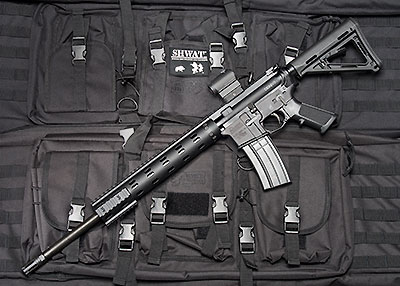 Like other Daniel Defense rifles, this one came with the Magpul MOE six position collapsible buttstock. Our M4V7 came without sights from Daniel Defense, which was no concern since we opted for an Aimpoint Micro T-1. Our T-1 is a 4 MOA unit; that essentially means it covers a four-inch circle at 100 yards. Not really a precision instrument, it’s very fast for both eyes open shooting, light weight (only 3.7 ounces without the mount), and night vision compatible. I’ve hit steel at 450 yards with this sight, but with our longer barrel, we might try a more precision optic and get some groups to report back. For tactical hog hunting, does it work and work well? You bet!
Like other Daniel Defense rifles, this one came with the Magpul MOE six position collapsible buttstock. Our M4V7 came without sights from Daniel Defense, which was no concern since we opted for an Aimpoint Micro T-1. Our T-1 is a 4 MOA unit; that essentially means it covers a four-inch circle at 100 yards. Not really a precision instrument, it’s very fast for both eyes open shooting, light weight (only 3.7 ounces without the mount), and night vision compatible. I’ve hit steel at 450 yards with this sight, but with our longer barrel, we might try a more precision optic and get some groups to report back. For tactical hog hunting, does it work and work well? You bet!
Now, let’s talk about our 6.8×43 mm round. Those who shoot it generally rave about it. I first killed pigs with the 6.8 hunting at the Wild River Ranch with its owner Chris Lucci and his guests from TNVC. Chris really is an authority on the round. He’s developed some of the loads now commonly used by many 6.8 shooters, and also worked in the development of some factory loads. He’s certainly a candidate for the title, “the guy that has shot more game animals than any one else in the world, using 6.8 X 43mm.”
The 6.8 is more versatile than some other options on the market. It can push a 80 grain bullet out a twelve inch barrel at a blazing 3000 feet per second, or a 140 grain bullet from a sixteen inch barrel at 2400 feet per second. Part of the appeal of this round is that it was designed to work with standard AR-15 geometry. The bolt and barrel are different, and dedicated 6.8 magazines are in order, but it’s only a matter of pushing two pins on your lower receiver to swap from a .223/5.56 upper receiver to a 6.8 upper assembly.
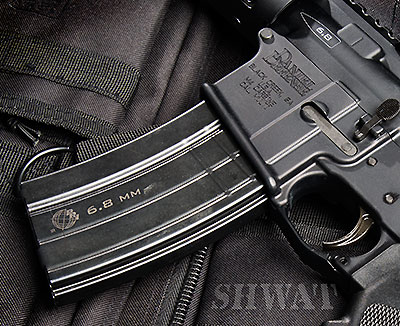 For tactical hog hunting, the 6.8 is ideal. Like many other hunting rounds, it costs more than your typical 5.56 surplus ammo. With current ammo costs, that could be hard to swallow for a high round count carbine class. When it comes to hunting, however, the 6.8 opens up some great options from coyotes and other small varmints, to medium game, even up to mule deer and some elk, in limited circumstances. Essentially, ballistic performance is similar to .243 Winchester from a six inch shorter barrel, with less blast and flash. Inside 300 yards, the 6.8 is a great hunting cartridge.
For tactical hog hunting, the 6.8 is ideal. Like many other hunting rounds, it costs more than your typical 5.56 surplus ammo. With current ammo costs, that could be hard to swallow for a high round count carbine class. When it comes to hunting, however, the 6.8 opens up some great options from coyotes and other small varmints, to medium game, even up to mule deer and some elk, in limited circumstances. Essentially, ballistic performance is similar to .243 Winchester from a six inch shorter barrel, with less blast and flash. Inside 300 yards, the 6.8 is a great hunting cartridge.
Once I mounted the Aimpoint Micro T-1, I headed out to the range to see how this rifle would shoot. I grabbed a few boxes of Silver State Armory 110 grain Barnes TSX. You don’t have to search very long to discover that Silver State Armory is highly invested in the 6.8 round. Unlike many ammunition manufacturers, they form their own brass instead of using once fired or surplus brass. SSA customers range from hunters to military and law enforcement both here in the USA and abroad.
Daniel Defense shipped our M4V7 with a single PRI brand 6.8 steel magazine. I loaded it with the SSA ammo and went shooting. With the standard H (heavy) buffer, it’s a great shooter, with a soft slow recoil impulse. Unsuppressed, it sounds different from a 5.56 too, with a bit longer “boom” and lesser “crack.”
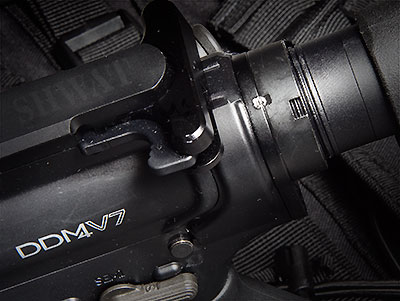 A final note on quality. As stated previously, some aspects of a rifle build matter more to certain people and less to others. I don’t like cutting corners. One thing I consistently look for is proper staking of the gas key and castle nut on AR rifles. Proper staking inhibits screws or nuts from backing out by pushing some metal from the surrounding surface into the screw or nut. Many companies only make visible marks that won’t hold, and I’ve had one rifle where they didn’t even attempt staking. Upon repeated firing, the castle nut worked its way loose. Not cool, folks. Daniel Defense does a great job here, properly staking everything. So, you bet, the reputation for quality is well deserved as seen in every aspect of this rifle.
A final note on quality. As stated previously, some aspects of a rifle build matter more to certain people and less to others. I don’t like cutting corners. One thing I consistently look for is proper staking of the gas key and castle nut on AR rifles. Proper staking inhibits screws or nuts from backing out by pushing some metal from the surrounding surface into the screw or nut. Many companies only make visible marks that won’t hold, and I’ve had one rifle where they didn’t even attempt staking. Upon repeated firing, the castle nut worked its way loose. Not cool, folks. Daniel Defense does a great job here, properly staking everything. So, you bet, the reputation for quality is well deserved as seen in every aspect of this rifle.
The SHWAT™ Team will run this gun in stock configuration for a while, but we have plans to upgrade and modify it to our liking. Isn’t that what AR-15s are all about…? Keep an eye out for more stories where it makes an appearance, takes out some hogs or poses in pictures!


